2019 KIA RIO HATCHBACK driver seat adjustment
[x] Cancel search: driver seat adjustmentPage 18 of 503
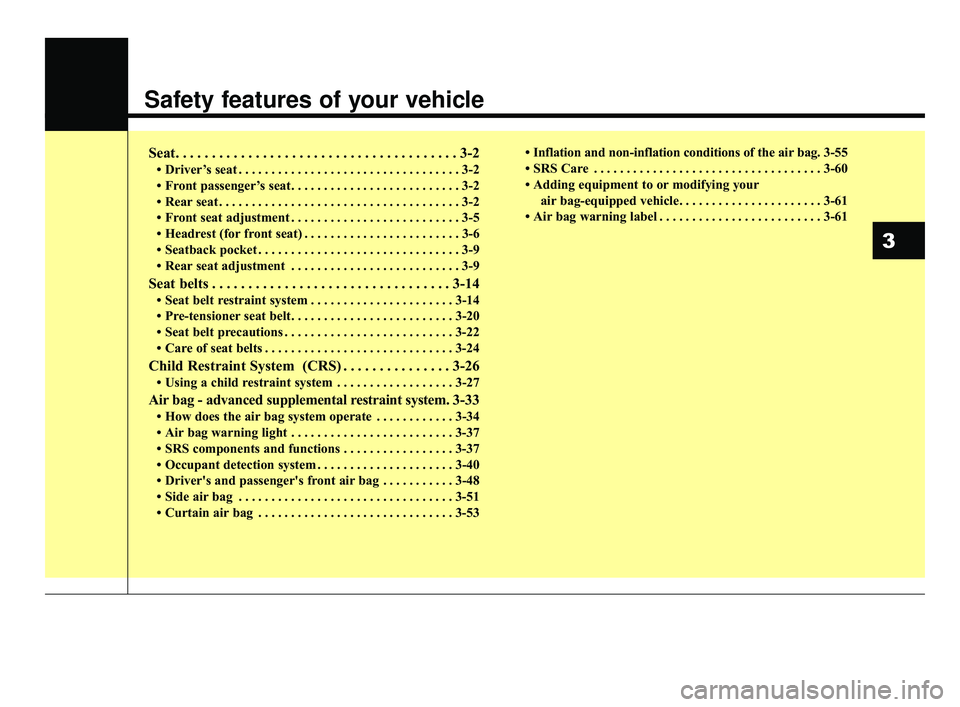
Safety features of your vehicle
Seat. . . . . . . . . . . . . . . . . . . . . . . . . . . . . . . . . . . . \
. . . 3-2
• Driver’s seat . . . . . . . . . . . . . . . . . . . . . . . . . . . . . . . . . . 3-2
• Front passenger’s seat. . . . . . . . . . . . . . . . . . . . . . . . . . 3-2
• Rear seat . . . . . . . . . . . . . . . . . . . . . . . . . . . . . . . . . . . . \
. 3-2
• Front seat adjustment . . . . . . . . . . . . . . . . . . . . . . . . . . 3-5
• Headrest (for front seat) . . . . . . . . . . . . . . . . . . . . . . . . 3-6
• Seatback pocket . . . . . . . . . . . . . . . . . . . . . . . . . . . . . . . 3-9
• Rear seat adjustment . . . . . . . . . . . . . . . . . . . . . . . . . . 3-9
Seat belts . . . . . . . . . . . . . . . . . . . . . . . . . . . . . . . . . 3-14
• Seat belt restraint system . . . . . . . . . . . . . . . . . . . . . . 3-14
• Pre-tensioner seat belt. . . . . . . . . . . . . . . . . . . . . . . . . 3-20
• Seat belt precautions . . . . . . . . . . . . . . . . . . . . . . . . . . 3-22
• Care of seat belts . . . . . . . . . . . . . . . . . . . . . . . . . . . . . 3-24
Child Restraint System (CRS) . . . . . . . . . . . . . . . 3-26
• Using a child restraint system . . . . . . . . . . . . . . . . . . 3-27
Air bag - advanced supplemental restraint system. 3-33
• How does the air bag system operate . . . . . . . . . . . . 3-34
• Air bag warning light . . . . . . . . . . . . . . . . . . . . . . . . . 3-37
• SRS components and functions . . . . . . . . . . . . . . . . . 3-37
• Occupant detection system . . . . . . . . . . . . . . . . . . . . . 3-40
• Driver's and passenger's front air bag . . . . . . . . . . . 3-48
• Side air bag . . . . . . . . . . . . . . . . . . . . . . . . . . . . . . . . . 3-51
• Curtain air bag . . . . . . . . . . . . . . . . . . . . . . . . . . . . . . 3-53 • Inflation and non-inflation conditions of
the air bag. 3-55
• SRS Care . . . . . . . . . . . . . . . . . . . . . . . . . . . . . . . . . . . 3-\
60
• Adding equipment to or modifying your air bag-equipped vehicle. . . . . . . . . . . . . . . . . . . . . . 3-61
• Air bag warning label . . . . . . . . . . . . . . . . . . . . . . . . . 3-61
3
SC CAN (ENG) 3.QXP 7/18/2018 5:54 PM Page 1
Page 20 of 503
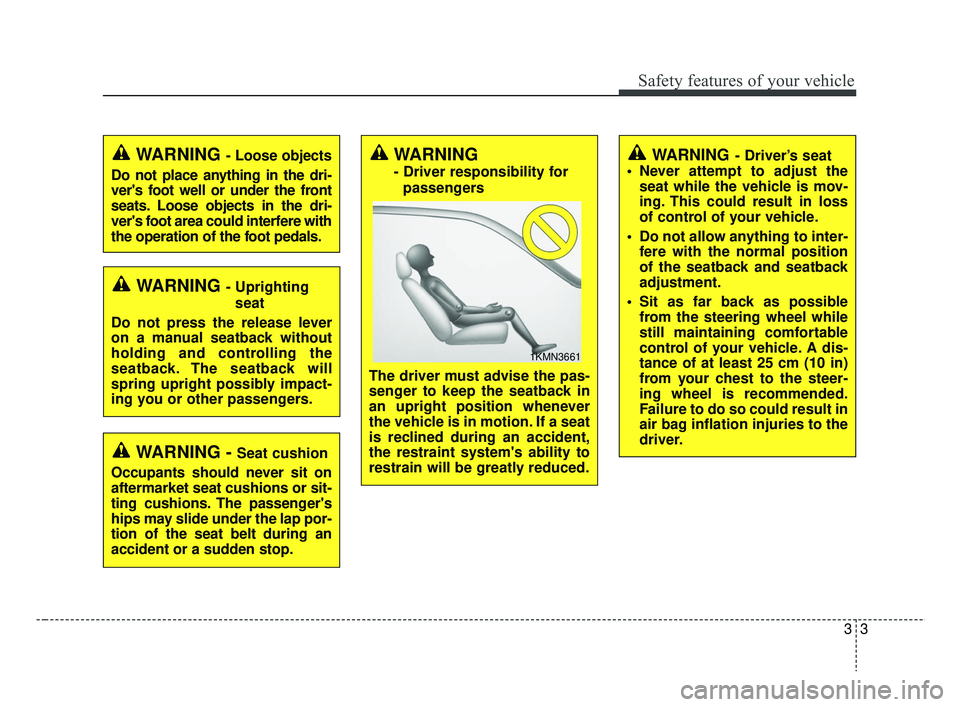
33
Safety features of your vehicle
WARNING - Uprightingseat
Do not press the release lever
on a manual seatback without
holding and controlling the
seatback. The seatback will
spring upright possibly impact-
ing you or other passengers.
WARNING- Loose objects
Do not place anything in the dri-
ver's foot well or under the front
seats. Loose objects in the dri-
ver's foot area could interfere with
the operation of the foot pedals.WARNING
- Driver responsibility for passengers
The driver must advise the pas-
senger to keep the seatback in
an upright position whenever
the vehicle is in motion. If a seat
is reclined during an accident,
the restraint system's ability to
restrain will be greatly reduced.
1KMN3661
WARNING - Seat cushion
Occupants should never sit on
aftermarket seat cushions or sit-
ting cushions. The passenger's
hips may slide under the lap por-
tion of the seat belt during an
accident or a sudden stop.
WARNING- Driver’s seat
Never attempt to adjust the seat while the vehicle is mov-
ing. This could result in loss
of control of your vehicle.
Do not allow anything to inter- fere with the normal position
of the seatback and seatback
adjustment.
Sit as far back as possible from the steering wheel while
still maintaining comfortable
control of your vehicle. A dis-
tance of at least 25 cm (10 in)
from your chest to the steer-
ing wheel is recommended.
Failure to do so could result in
air bag inflation injuries to the
driver.
SC CAN (ENG) 3.QXP 7/18/2018 5:54 PM Page 3
Page 22 of 503
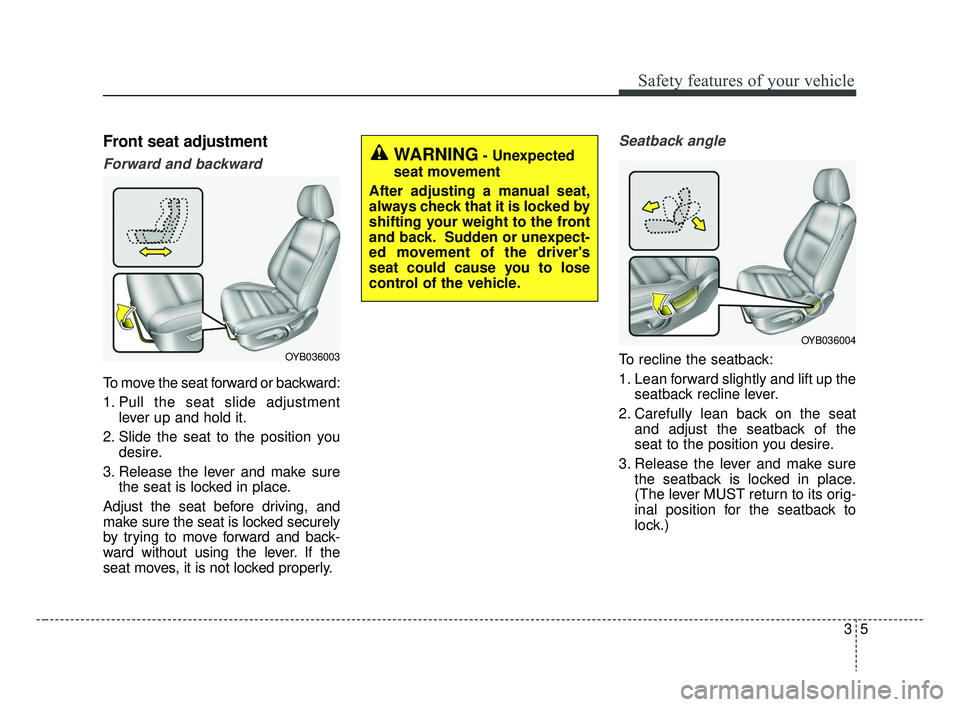
35
Safety features of your vehicle
Front seat adjustment
Forward and backward
To move the seat forward or backward:
1. Pull the seat slide adjustmentlever up and hold it.
2. Slide the seat to the position you desire.
3. Release the lever and make sure the seat is locked in place.
Adjust the seat before driving, and
make sure the seat is locked securely
by trying to move forward and back-
ward without using the lever. If the
seat moves, it is not locked properly.
Seatback angle
To recline the seatback:
1. Lean forward slightly and lift up the seatback recline lever.
2. Carefully lean back on the seat and adjust the seatback of the
seat to the position you desire.
3. Release the lever and make sure the seatback is locked in place.
(The lever MUST return to its orig-
inal position for the seatback to
lock.)OYB036003
WARNING- Unexpected
seat movement
After adjusting a manual seat,
always check that it is locked by
shifting your weight to the front
and back. Sudden or unexpect-
ed movement of the driver's
seat could cause you to lose
control of the vehicle.
OYB036004
SC CAN (ENG) 3.QXP 7/18/2018 5:54 PM Page 5
Page 23 of 503
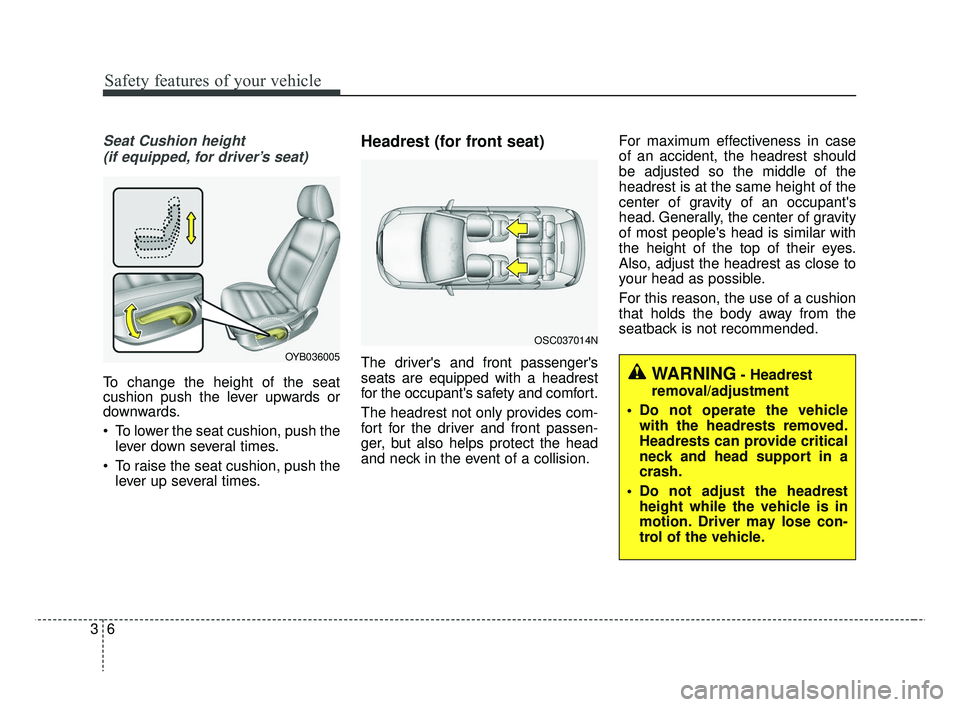
Safety features of your vehicle
63
Seat Cushion height (if equipped, for driver’s seat)
To change the height of the seat
cushion push the lever upwards or
downwards.
To lower the seat cushion, push the lever down several times.
To raise the seat cushion, push the lever up several times.
Headrest (for front seat)
The driver's and front passenger's
seats are equipped with a headrest
for the occupant's safety and comfort.
The headrest not only provides com-
fort for the driver and front passen-
ger, but also helps protect the head
and neck in the event of a collision. For maximum effectiveness in case
of an accident, the headrest should
be adjusted so the middle of the
headrest is at the same height of the
center of gravity of an occupant's
head. Generally, the center of gravity
of most people's head is similar with
the height of the top of their eyes.
Also, adjust the headrest as close to
your head as possible.
For this reason, the use of a cushion
that holds the body away from the
seatback is not recommended.OYB036005
WARNING- Headrest
removal/adjustment
Do not operate the vehicle with the headrests removed.
Headrests can provide critical
neck and head support in a
crash.
Do not adjust the headrest height while the vehicle is in
motion. Driver may lose con-
trol of the vehicle.
OSC037014N
SC CAN (ENG) 3.QXP 7/18/2018 5:55 PM Page 6
Page 33 of 503
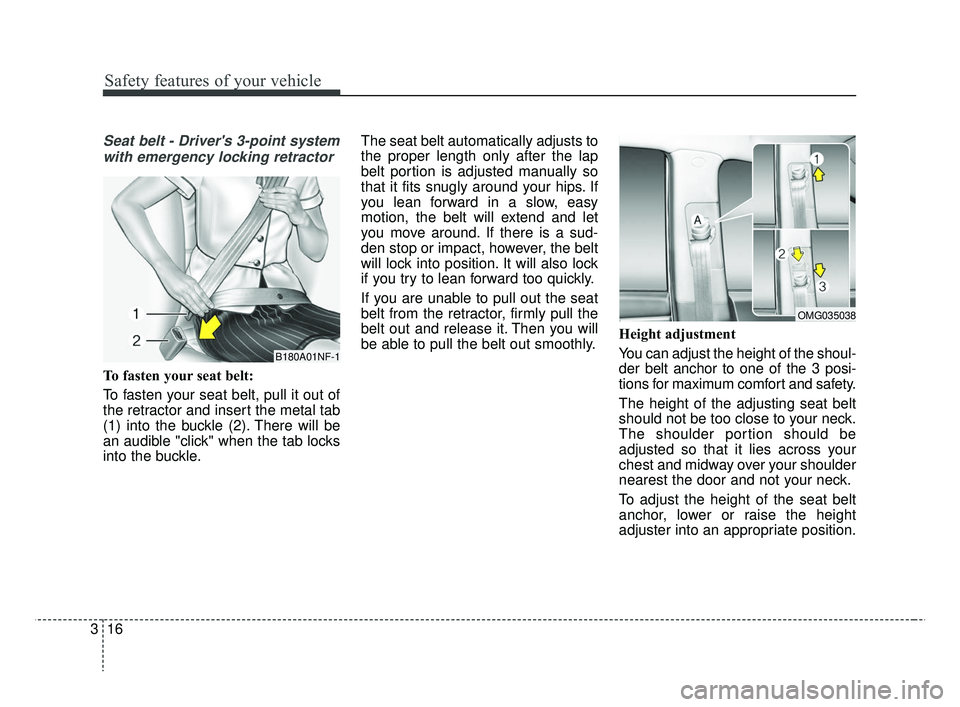
Safety features of your vehicle
16
3
Seat belt - Driver's 3-point system
with emergency locking retractor
To fasten your seat belt:
To fasten your seat belt, pull it out of
the retractor and insert the metal tab
(1) into the buckle (2). There will be
an audible "click" when the tab locks
into the buckle. The seat belt automatically adjusts to
the proper length only after the lap
belt portion is adjusted manually so
that it fits snugly around your hips. If
you lean forward in a slow, easy
motion, the belt will extend and let
you move around. If there is a sud-
den stop or impact, however, the belt
will lock into position. It will also lock
if you try to lean forward too quickly.
If you are unable to pull out the seat
belt from the retractor, firmly pull the
belt out and release it. Then you will
be able to pull the belt out smoothly.
Height adjustment
You can adjust the height of the shoul-
der belt anchor to one of the 3 posi-
tions for maximum comfort and safety.
The height of the adjusting seat belt
should not be too close to your neck.
The shoulder portion should be
adjusted so that it lies across your
chest and midway over your shoulder
nearest the door and not your neck.
To adjust the height of the seat belt
anchor, lower or raise the height
adjuster into an appropriate position.
B180A01NF-1
OMG035038
SC CAN (ENG) 3.QXP 7/18/2018 5:55 PM Page 16